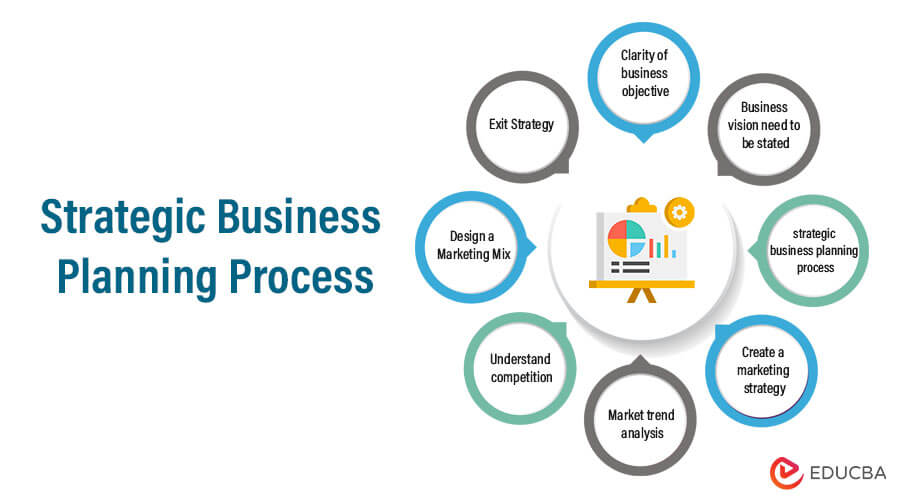Introduction to Strategic Business Planning Process
Many new organizations are ready to enter the market daily to profit from their business idea and market potential. In a competitive scenario like the present one, companies are fighting with each other for even a smaller portion of market share, trying to create a space for themselves through market demand. Among such competition, some organizations still perform well, and those fail to deliver in the first six months of existence. Did it ever occur to you why it has happened? Why do companies with similar products targeting the same market segments have different profit levels? If not, then this is where you may find the answer.
Differentiation is not just a term, but it is imperative to practice in real business scenarios, and what differentiates an organization from another is strategic business implementation. It is not essential to only enter the market considering the market potential. Still, it is crucial to plan strategically how to enter and when to ensure every action taken by the entrepreneur falls as expected. If you are in the next league of starting a new venture, it is essential to understand the importance of a strategic business plan. It is based on an appropriate strategic business planning process so that an organization can survive longer.
Creating a strategic business planning process before starting a business activity is crucial to ensure all areas are well covered and each step is taken with a complete understanding of the industry and the customer. The plan also includes market exceptions and strategies to construct a more substantial base for the organization to sustain intense competition from the industry at any time. Are you still quizzed about what exactly we are talking about here? If so, then you are on the right page; this article will help you assist with an overall guideline on how to design a strategic business planning process.
Essential Points to Create Strategic Business Planning Process
To create a strategic business planning process, you may need to keep certain important things in mind, and they are:
1. Clarity of Business Objective
Did it ever occur to you that exactly why do you aspire to conduct business in a competitive environment? If not, this may be the ideal time to think about it. A company is a series of activities that needs a proper strategic business planning process and implementation, but that would only be possible if the objective of doing the business is clearly defined. A business may be conducted for various reasons such as ‘To gain international market exposure and expand knowledge in new territories’…. ‘To increase the sales of companies existing products as well as introduce a new innovative product on the same lines,’ etc. A clear business objective helps an organization have a larger vision and helps it plan for longer.
2. Business Vision Needs to be Stated
Vision can be related to each organization’s aspiration to have a consistent performance and market aspiration. Well-established visions of an organization help its stakeholders relate to it and inspire people working with it. A business vision mainly includes the purpose, value, and long-term goals of the organization.
3. A mission is Essential for a Strategic Business Planning Process
A mission is essential for the management’s confidence and those associated with the organization, i.e., the customer. Placing a vision in a strategic business planning process leaves scope for business expansion; it directs other business activities toward achieving the organization’s long-term mission. The mission can be three to four lines, but it tells much about the company’s plans to insiders and outsiders. A company’s mission may seem like ‘The Company aspires to target new markets with competitive products in the next five years.’ Suppose you, as an entrepreneur, have an aspiration for your company. In that case, it must be reflected in the mission statement to help the stakeholders understand the direction of your strategic business plan and execution.
4. Create a Marketing Strategy
Each business is unique and different from the others in some other way. Therefore, marketing its products must also differ from others in the competition. What do you understand by marketing strategy? If you feel this is not your area of competence or your company may not need it … then you might be wrong. Every company needs a marketing strategy as it lays down the strategic business planning process and execution of utilizing the organizational resources. Marketing strategy is a critical factor that helps the organization assess the current market competition by understanding the external and internal environment of the company.
Many techniques and tools, such as SWOT analysis, can be applied to create a marketing strategy for your organization. This analysis highlights the strengths and weaknesses of the organization vis-à-vis the external environment or the country’s industrial environment the organization would face. It also highlights the opportunities and threats a company would meet in a similar environment.
PESTEL analysis is another tool that can help you create a marketing strategy for your business. It enables the organization to understand the political, economic, social, technological, environmental, and legal factors associated with the external environment. These factors can help you design appropriate strategies to enter the market, explain how to operate in the competitive scenario, define parameters for the organizational objectives, and use a strategy to expand into new territories or have a safe exit from the industry.
5. Market Trend Analysis
Did it ever occur to you that among many factors, what would be the most crucial to creating an establishment that would ensure minimal risk? Understanding the market trend is vital as it provides the appropriate information and statistics to help a company plan its financial and operational activities appropriately. The market trend reflects the overall behavior of the industry concerning product acceptability, market accessibility, constraints, and product demand among customers.
Each market has a trend where products are acceptable due to their innovative technology or unique features; the analysis would help understand the same and design the strategic business plan accordingly. The market analysis must clearly explain the market segmentation. This helps identify the particular segment the company is targeting; market forecast explains the future expectations about the market. The customers mainly drive the market. Therefore, the trend analysis needs to focus on the customers’ needs and preferences that regulate the market and their buying decisions. The data and information from conducting market analysis help create a strategic business plan.
6. Understand the Competition
Do you think market competition positively and negatively impacts the organization’s performance? If yes… then we are on the same page. Market competition regulates business activities across industries and inspires new entrants to be innovative. Competition is mainly driven by market accessibility and the credibility of a company or brand value in the industry for a longer period. For the customer, it is easier to trust a new product of an existing company rather than an old one from a new company due to either the trust factor or the competitive pricing that a current organization can provide because of economies of scale.
It is crucial to understand the existing competition to identify the scope of potential innovation in your product to create differentiation among customers and their strategies related to the market operation. It is essential to understand your competitive position concerning the existing competition in the industry to create demand for our product and forecast sales. Competitor analysis is an integral part of the strategic business planning process. Without this, an entrepreneur fails to launch a business proposition successfully in the industry.
7. Design a Marketing Mix
As a part of the strategic business planning process, having a marketing mix is crucial and implies ways a product can be successfully launched in the market. Have you ever wondered on what basis companies design the product, price, positioning, and process of introducing the new product? ….. If not, this section will provide all the necessary details for your strategic business planning process. To create a desirable proposition for the customer, a company must design a valuable marketing mix involving product innovation, pricing strategies to create differentiation using advanced technologies, and product positioning concerning the market, i.e., premium, local, or global.
Placement is also crucial to create an exact fitment of the product in the required market. The process is the systematic functioning from planning to the execution of the product and people who contribute a great differential from creating the product to introducing it in the market as well as making sure that the demand for the product also remains and promotion is the last yet most effective method to make sure that the demand for the product is created at the right time as well as among the target segment.
8. Exit Strategy
Have you ever considered companies that may have started at a massive level but suddenly disappeared smoothly? What happened to them? Where did they go, and how? … These questions are essential to answer, especially when getting into a competitive industry today. The strategic business plan must have options clearly stating that in case the business proposition did not work well as per planning, then how the entrepreneur seeks to exit the market. A safe exit with minimum losses is a crucial part of the strategic business planning process, considering the financial losses it may bear and harm the goodwill of a brand name. Selling off everything and eloping from accountability is never a solution; the way out must be strategically suitable for people with financial investment and those working for the organization.
Human resources forms a strong asset for the organization. Therefore, the exit strategy must clearly state how to allocate its human resources and capital most effectively and efficiently. An exit strategy must also have a timeline to analyze the risk-taking capacity of the organization; along with that, it defines the foresightedness of the entrepreneur and the organization’s viability. The ways to minimize losses must also be clearly defined, and an analysis of how an entrepreneur plans to recover losses is extremely imperative.
9. Timelines
The strategic business plan must have appropriate timelines mentioned from the inception of the idea till execution to streamline the processes involved as well as keep the objectives in the practical form. Having timelines designed on paper would give certainty to the plans and motivate the entrepreneur to complete the task within the time frame. The timeline must also include the possibility of extensions due to unforeseeable reasons or due to any technical diligence. Creating opportunities for such diligence keeps the entrepreneur technically and financially prepared without causing any unnecessary burden and creating a feeling of demotivation within the system.
It is believed that after reading this article, the reader will get all the required information and foresight to plan. And then design a strategic business plan for his new venture in the most appropriate manner.
Recommended Articles
This guides a strategic business planning process based on appropriate planning. Due to this, an organization can survive for a more extended period. These are the following external links related to the strategic business plan.





